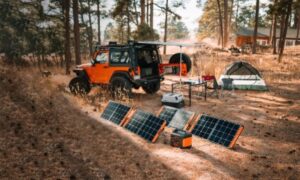What is hydroelectric power?
Hydroelectric power is a form of renewable energy that generates electricity by harnessing the energy of flowing water.
This process involves the use of turbines and generators to convert the kinetic energy of water into electrical energy.
Hydroelectric power plants are typically located near rivers, dams, or other bodies of water with strong currents.
The technology used in hydroelectric power plants has been around for over a century and is one of the most widely used forms of renewable energy in the world today.
How does hydroelectric power work?
The process begins with the construction of a dam on a river, which creates a reservoir of water behind it.
As water flows downstream, it passes through turbines, which are connected to generators that convert the kinetic energy of the flowing water into electrical energy.
The amount of electricity generated by a hydroelectric power plant depends on several factors, including the height of the dam (known as the head), the amount of water flowing through the turbines (known as the flow rate), and the efficiency of the turbines and generators.
In general, larger dams with greater head and flow rates are capable of generating more electricity.
Hydroelectric power is a highly efficient and reliable source of electricity, with some plants able to operate at full capacity for decades without interruption.
Additionally, because it relies on natural sources of energy (i.e. moving water), it produces no greenhouse gas emissions or other pollutants.
Overall, hydroelectric power is an important component of our renewable energy mix and will likely continue to play an important role in meeting our growing demand for electricity in a sustainable and environmentally friendly way.
Advantages of hydroelectric power
Hydroelectric power is a renewable and clean source of energy that has several advantages over traditional fossil fuels. Some of the benefits of hydroelectric power include:
– Low operating costs: – Once a hydroelectric plant is built, the operating costs are relatively low compared to other types of power plants.
This is because water is a free resource and there are no fuel costs associated with generating electricity from flowing water.
– Reliable and predictable: – Hydroelectric power plants can generate electricity consistently as long as there is enough water flowing through the turbines.
This makes it an ideal source of base load power that can meet the constant demand for electricity.
– No greenhouse gas emissions: – Unlike fossil fuels, hydroelectric power does not produce any greenhouse gas emissions or other pollutants that contribute to climate change.
This makes it a much cleaner source of energy that can help reduce our carbon footprint.
– Flood control: – Hydroelectric dams can also be used for flood control by storing excess water during heavy rains and releasing it gradually over time.
This helps prevent flooding downstream and protects communities from damage.
– Recreation opportunities: – Hydroelectric dams often create reservoirs that can be used for recreational activities such as boating, fishing, and swimming.
These reservoirs can also provide habitat for fish and wildlife, making them popular destinations for nature lovers.
Overall, hydroelectric power has several advantages over traditional fossil fuels that make it an attractive source of renewable energy for our future energy needs.
Disadvantages of hydroelectric power
Hydroelectric power has several disadvantages that should be considered before deciding to build a hydroelectric power plant.
Some of the main disadvantages are:
– Environmental impact: – Building a hydroelectric power plant requires flooding large areas of land which can have a negative impact on the environment.
The flooding can destroy habitats for wildlife and displace people who live in the area.
– Limited availability: – Hydroelectric power is only available in areas where there is running water, which limits its availability compared to other sources of energy.
– Expensive to build: – Building a hydroelectric power plant can be very expensive, especially if it requires building dams or other large structures.
– Maintenance costs: – Maintaining a hydroelectric power plant can also be expensive, as it requires regular inspections and repairs to ensure that the equipment is working properly.
– Weather-dependent: – Hydroelectric power generation is weather-dependent, meaning that it can be affected by droughts or changes in water flow.
Despite these disadvantages, hydroelectric power remains an important source of renewable energy and has many benefits over non-renewable sources such as coal or oil



































